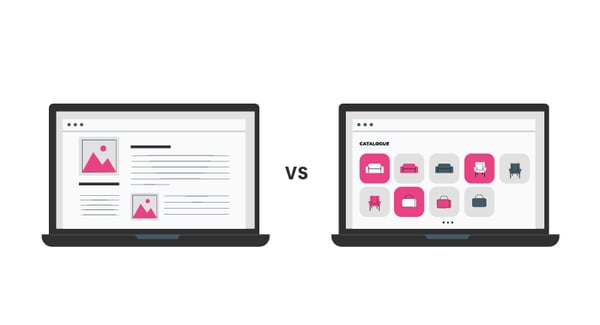Website is like your first image. In this blog content, I will be sharing some practical steps for building or revamping a B2B website, you’ll soon be able to build credibility and generate leads with ease!
For B2B, your website acts as your ‘salesperson’, representing your brand and providing an easier way to get a business’ products and services in front of the prospects. In order to stand out among this fierce competition, it is crucial to design a well-designed and effective B2B website.
By following the B2B website guidelines, you’ll be able to build credible websites which generate leads sustainably! Before we dive into B2B website practices, it is important to highlight the disparities between B2B and B2C website design.

Differences between B2B and B2C Website
Nearly all standard user-experience principles can be applied to both. However, the needs of consumers and businesses tend to differ. There are some critical differences that you should pay attention to.
Goals
Building quick interest and encouraging fast purchases are typical goals of the B2C website. So, the website design and product must be catching and compelling, in order to stand out in a crowd of competitors.
On the other hand, a B2B website is eager to build a closer relationship with customers, exhibiting a professional image, and offering valuable content and solutions for businesses.
Buyer’s Journey
B2C websites are usually aimed at individual customers. Most of their customers are looking for a convenient and smooth buying experience. Offering consistent usability and a smooth checkout process is a crucial part of a B2C buyer journey.
Commonly, B2B customers are rarely impulsive, because B2B products or services are priced higher than the products listed on the B2C website. All of the buyers surveyed are involved in B2B purchases with 64 percent setting strategy and 44 percent authorizing purchases. Almost nine in 10 were manager level and above, and the majority (57 percent) worked at enterprise companies with 1,000 or more employees. And about one-quarter is from the tech sector.
A buyer’s decision making for a B2B purchase has always involved a team of people following a set of procedures, resulting in a longer and more complex process.
Lead Cycles
The decision making of B2C user journeys is much more straightforward. Meanwhile, the lead and lifecycle of a B2B purchase are usually much longer. 75% of B2B takes at least 4 months to close a deal to become a customer, with almost half taking 7 months or more. B2B websites are usually positioned for longer buying and sales cycles that focus more on education and nurturing instead of urgency. 
8 Practical Steps to Create a Successful B2B Website
1. Develop a Strong Foundational Strategy
First and foremost, developing a website strategy will help you build a solid foundation to build your website on. Spending time and energy in the strategy state is critical. First, set your website goals. Try to develop a clear understanding of your business objectives that you aim to achieve through your website by holding interviews with stakeholders across different teams. The second step is to understand your target persona and how your website can solve their problems along the buyer’s journey. Hosting user interviews and conducting customer surveys can be effective ways to achieve this step.
Once you’ve determined the business goals and target audiences, create a page description diagram to prioritize your web content before you create the wireframe.
2. Create an Effective User Experience
After you map out your buyer’s journey, you can create detailed buyer personas for your business. A buyer persona is a representation of your ideal customer based on user research and data. This helps you easier to tailor your content and messaging that appeals to your target audience.
As soon as you’ve created your customer personas, bridging the gap between business goals and user needs will be the next step. As mentioned above, building a closer relationship with customers is the goal of a B2B website. Creating an effective and compelling user experience is extremely important for B2B customers. Working with wireframes and prototypes are the critical initial steps in creating the user journey more efficiently.
3. Implement Minimalistic Website Design for Clearer Navigation
Minimalist design is used to create an intuitive website for its users, which is particularly helpful in enhancing user experience. An organized hierarchy of the website makes it easy to navigate. HubSpot has found that 76% of consumers say the most important factor in a website's design is "the website makes it easy for me to find what I want." Based on the research in the user journey, you may define the navigation by products/solutions, or by applications/solutions, or sometimes by industries to make sure users at different stages of the journey can find the right content by different ways.
A search bar on your website is also paramount, allowing your users to find things faster. You can also keep track of users’ site search behaviors, which help you to understand more about what your customers/prospects are looking for.
4. Improve Lead Generation with High Quality Content and Effective CTAs
High quality content is valuable in nurturing your prospects. So it is essential to make sure you’ve offered large amounts of high-quality, relevant content to your target audiences. Content like webinars, ebooks, blogs, white papers, etc. are some of the best examples to help you build credibility with prospects and stand out among your competitors. Make sure your content is educational, unique, relevant, and fresh which will in turn boost search engine ranking for the website.
Moreover, do not underestimate the power of an effective call-to-action. Using visible and consistent call-to-action(CTA) is incredibly important for turning website visitors into engaged prospects. Clearly outlining your primary and secondary CTAs can provide a smooth website flow to nurture prospects towards the desired end goal.
5. Build Credibility by Provide Social Proof Elements
Social proof is an idea that people conform to the actions of others under the assumption that those actions are reflective of the correct behavior. Here are some forms of social proof that can be incorporated into your B2B marketing: user testimonials, client reviews, case studies, and business credentials. Social proof offers trustworthiness and credibility, which can persuade visitors. This is definitely a critical investment that helps to build positive brand recognition, stand out from the competition, boost sales and grow traffic.
6. Adopt a Smarter Website Redesign Methodology - Growth Driven Design
It is crucial to keep your website updated, user-focused, and always optimized. Growth-Driven Design (GDD) is an agile approach to build your website more efficiently which allows the continuous experimenting and optimizing. It reduces risks and drives peak performance. You can continuously collect data of users’ interaction with your pages to optimize your content and update the website design.
Check out our blog about Growth Driven Design (GDD) to understand how it works.
7. Utilize a Secure and Scalable Content Management System (CMS)
CMS is a better website option which allows you to manage content easily and build the website on a modular basis. Whereas, HTML based websites are static which makes it difficult for content change.
There are lots of different CMS, the most commonly used platforms are WordPress and HubSpot. WordPress is very flexible, but it is notorious for its security flaws. But with HubSpot, your website security is covered, with great features such as:
- Firewall / VPN
- Secure Sockets Layer (SSL) Protection
- Intrusion Detection System (IDS)
- Distributed Denial of Service (DDoS) Mitigation
- 24/7 Security and Threat Monitoring
- Custom CDN Configuration
8. Integration with CRM, Marketing and Sales Seamlessly
Marketing and sales go hand in hand with each other. Seamless integration with your CRM, marketing and sales platform will improve efficiencies and give you control over all aspects of your business. HubSpot’s all-in-one marketing and sales platform brings your entire marketing funnel together. With HubSpot, you can glean insights about your website visitors, offer personalized experience for your customers, and monitor your sales activities for more control and better results.

A website plays a major role for B2B business which you need to ensure it offers satisfying experiences to your prospects and customers. Following these tips and strategies can help you to build your B2B website more efficiently and effectively. We are here to help you implement GDD and inbound marketing. Talk to our specialist to understand more!

